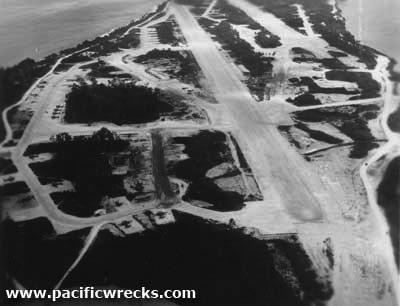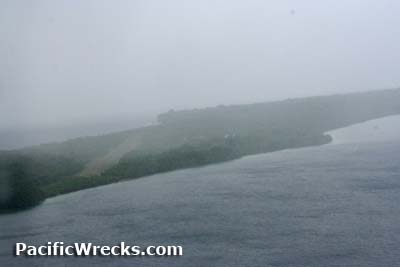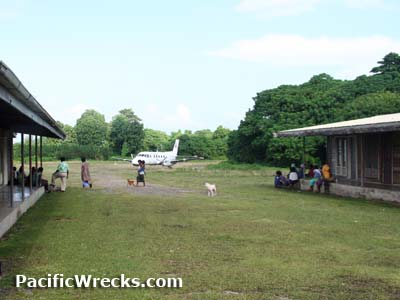|
|
|
|
| Missing In Action (MIA) | Prisoners Of War (POW) | Unexploded Ordnance (UXO) |
| Chronology | Locations | Aircraft | Ships | Submit Info | How You Can Help | Donate |
|
 USAAF c1945  USMC c1945    New Zealand Police 2006 |
Location Nissan Airfield is located on Nissan Island (Green Island) in Green Island Atoll bordering the Pacific Ocean to the east and Green Island Lagoon to the west. Also known as "Green Island Airfield" or simply "Green". Today known as "Nissan Island Airport". Sometimes incorrectly spelled Nissian Airfield. Prewar and during the Pacific War located in the Territory of New Guinea. Postwar located in North Solomons Province later renamed Bougainville Province. Today located in Autonomous Region of Bougainville (AROB) in Papua New Guinea (PNG). Prewar During the late 1890s, Germans planted two copra plantations including Tangalan Plantation on Nissan that operated until World War I. After 1918, the plantations were operated by Australians until the start of the Pacific War. Also, Roman Catholic Marist missionaries built a church, school and dispensary on Nissan Island. Wartime History During January 1942, Green Island Lagoon was briefly used by the Japanese Navy as a forward seaplane operating area, prior to the occupation of Rabaul. early 1944, a small Japanese base force of roughly 500 troops were stationed on Nissan Island, the rest had withdrawn to Feni Island. During the Japanese occupation, no airfield was built at this location. On February 15, 1944 Allied troops made an amphibious landing as part of "Operation Square Peg". About 500 Japanese base troops defended the island and fought to the death. After the island was declared secure on February 23, 1944, construction of an airfield began. Construction Nissan Airfield was built on Tangalan Plantation by the U.S. Navy Construction Battalion "Seabees". Two parallel runways were built: Lagoon Airfield (Fighter Strip) and Ocean Airfield (Bomber Strip). Wartime History Nissan Airfield was designated U.S. Army APO 717, Unit 1. The airfield was used by aircraft from the U.S. Army Air Force (USAAF), U.S. Navy (USN), U.S. Marine Corps (USMC) and Royal New Zealand Air Force (RNZAF). During early March 1944 until the end of October 1944, Nissan Airfield was used for missions against Japanese targets including Rabaul on New Britain and New Ireland. Allied units at Nissan Airfield (Green Island) U.S. Navy (USN) 93rd NCB (Seabees) February 15, 1944–October 25, 1944 15th NCB (Seabees) February 22, 1944–April 3, 1944 33rd NCB (Seabees) March 1944–July 1944/August 1944 VB-115 (15 x PB4Y-1) Munda April 10, 1944–May 26, 1944 Mokmer/Wakde U.S. Marine Corps (USMC) MAG-24 MAG-14 VMSB-341 (SBD) April 1944–May 1944/July 1, 1944 VMSB-223 (SBD) May 7, 1944–? VMF-218 () October 1944–December 1944 VMF-222 (F4U/FG Corsair) 1944–December 1944 VMF-223 (F4U) March 1944 VMB-423 (PBJ) Stirling arrives June 21, 1944 (ground echelon) Espirito Santo June 1944–June 1945 Emirau VMB-413 (PBJ) Stirling middle 1944 VMB-443 (PBJ) US arrives August 1944–August 30, 1944 departs Emirau U.S. Navy (USN) VPB-53 (PBY) ? - July 1945 Guiuan (Samar) Special Task Air Group One (STAG-1) (TDR Assault Drone) Banika / Stirling Oct 1944-Oct 27, 1944 disbanded Royal New Zealand Air Force (RNZAF) No. 18 Squadron (F4U) arrives November 1944–December 1944 No. 20 Squadron (F4U) arrives November 1944 No. 14 Squadron (F4U) Torokina arrives December 1944–January 1945 No. 16 Squadron (F4U) Torokina arrives December 1944–February 1945 departs Jacquinot Bay No. 17 Squadron (F4U) Torokina arrives January 1945–March 1945 No. 15 Squadron (F4U) arrives February 1945–April 1945 No. 24 Squadron (F4U) arrives March 1945–May 1945 No. 21 Squadron (F4U) arrives April 1945–May 18, 1945 departs Jacquinot Bay Lagoon Airfield (Fighter Strip) Lagoon Airfield was built on the lower part of a peninsula jutting out from the Nissan Island bordering Green Island Lagoon to the west. Also known as "Lagoon Airdrome" or "Lagoon Field". The control tower was code named "Lagoon". This was the first runway built by U.S. Navy Construction Battalion "Seabees", surfaced with crushed coral (coronus) for use as a fighter strip. On March 3, 1944 the first plane to land on the new runway was a disabled Corsair. During the first week of March 1944, the 5,000' in length surfaced with crushed coral was completed. This runway was abandoned by February 1945. FG-1A Corsair 13316 Pilot Sturgis force landed October 10, 1944 pilot survived, aircraft written off Ocean Airfield (Bomber Strip) Ocean Airfield located on the seaward side of Nissan Island bordering the Pacific Ocean. Also known as "Ocean Airdrome". This was the second runway built by U.S. Navy Construction Battalion "Seabees", surfaced with crushed coral (coronus) for use as a bomber strip. The runway was completed March 29, 1944 and measured 7,300' long by 200' wide. The control tower was code named "Ocean". The same day used by a B-24 Liberator that crash landed on the new runway. A note to pilots was: "Not to approach the island less than 1,000 feet when possible, as the [Green Island] atoll is difficult to locate at low altitude." Many famous Americans served or visited Nissan Island. U.S. Navy (USN) Lt. Richard M. Nixon, Officer in Charge of the Combat Air Transport Command (CATC) on Nissan (Green Island) who later became the 37th President of the United States (POTUS) during 1969-1974. Civilian Charles A. Lindbergh flew with U.S. Marine Corps (USMC) aviators based at Nissan (Green) and Emirau, flying combat missions as an "observer" with VMF-115, VMF-212, VMF-218 and VMF-222 during May to June 1944. On May 22, 1944 he flew on a strafing mission over Rabaul and afterwards noted in his diary, "The more I see of the Marines the more I like them." His last mission was on June 9, 1944 flying an escort mission over Rabaul. On June 10, 1944 Lindbergh departed for Espiritu Santo. Between May 22, 1944 until June 10, 1944, Charles Lindbergh flew thirteen combat mission with a U.S. Marine Corps (USMC) F4U Corsair squadron based at Green (Nissan) and Emirau and escorted TBF Avengers over Rabaul and strafed ground targets. Bob Hope preformed on Nissan August 1-2, 1944 and Jack Benny on August 15, 1944. Until early June 1944, New Zealand Army troops remained on Nissan before withdrawing to New Caledonia. Between May 20, 1944 until June 9, 1944 civilian aviator Charles A. Lindbergh flew with U.S. Marine Corps (USMC) pilots at Green Island Airfield (Nissan) and Emirau Airfield as an "observer" on combat missions with VMF-115, VMF-212, VMF-218 and VMF-222. On June 10, 1944 Lindbergh departed the war zone for Espiritu Santo. Special Task Air Group 1 (STAG-1) at Nissan Airfield During October 1944 Special Task Air Group 1 (STAG-1) operated TDR Attack Drone radio controlled aircraft with a live television broadcast to a "mother" control aircraft. STAG-1 was part of a top secret project to test the United States first guided missile flying combat missions from Nissan Airfield (Green Island) including: October 5, 1944 four drones launched against targets in Rabaul. October 9, 1944 (mission VK-11) four drones attack the causeway at Matupi, mission failed. October 15, 1944 (mission VK-12) four drones attack the causeway at Matupi, mission failed. October 26, 1944 four drones launched against targets in Rabaul By February 1945, Lagoon Airfield was noted as abandoned and today is overgrown. Ocean Airfield remained in use. By July 1945, the last Allied personnel departed the Nissan Island (Green Island). Everything left on the island was destroyed or abandoned and the island was returned to the native inhabitants. Today Ocean Airfield is still in use today and known as "Nissan Island Airport". The single runway measures 3,937'. Airport code: IATA: IIS. Used by regional airlines including Airlink for local flights to Tokua Airport (New Rabaul Airport) near Rabaul or charter flights. References Airdromes Guide Southwest Pacific Area July 1945 Corsair page 67 Contribute
Information Last Updated
|
Feb 1945 Map July 1945 Lagoon Airfield view in Google Earth Ocean Airfield view in Google Earth Photo Archive |
| Discussion Forum | Daily Updates | Reviews | Museums | Interviews & Oral Histories |
|